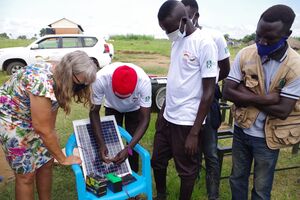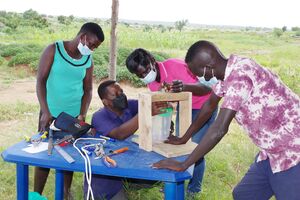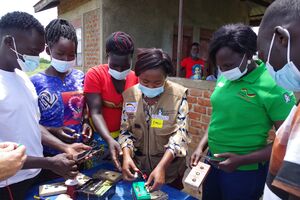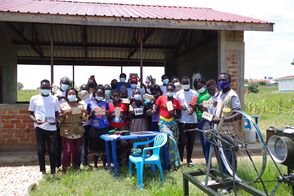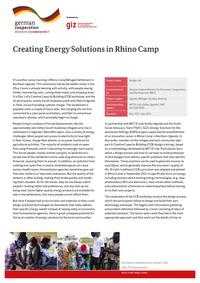Knowledge fuels change - Support energypedia!
For over 10 years, energypedia has been connecting energy experts around the world — helping them share knowledge, learn from each other, and accelerate the global energy transition.
Today, we ask for your support to keep this platform free and accessible to all.
Even a small contribution makes a big difference! If just 10–20% of our 60,000+ monthly visitors donated the equivalent of a cup of coffee — €5 — Energypedia would be fully funded for a whole year.
Is the knowledge you’ve gained through Energypedia this year worth €5 or more?
Your donation keeps the platform running, helps us create new knowledge products, and contributes directly to achieving SDG 7.
Thank you for your support, your donation, big or small, truly matters!
Creating Energy Solutions in Rhino Camp
Context and Background
It’s another sunny morning in Rhino Camp Refugee Settlement in Northern Uganda. The community hall by the health center in the Ofua 3 zone is already teeming with activity, with people sawing timber, hammering nails, cutting sheet metal, and stripping wires. It is Day 2 of a Creative Capacity Building (CCB) workshop, and the 16 participants, mostly South Sudanese youth who fled to Uganda in 2016, are each building a phone charger. The excitement is palpable when a couple of hours later, the charging kits are first connected to a solar panel and battery, and then to some brave volunteers’ phones, which promptly begin to charge.
People living in contexts of forced displacement, like the approximately one million South Sudanese refugees who live in settlements in Uganda’s West Nile region, face a variety of energy challenges. Most people lack access to electricity to have light in their homes, charge their phones, or to power machines for agricultural activities. The majority of residents cook on open fires using firewood, which is becoming increasingly more scarce. This forces people, mostly women and girls, to leave the protected area of the settlement and to walk long distances to collect firewood, exposing them to assault. In addition, air pollution from cooking over open fires in poorly ventilated spaces can cause serious health issues. Humanitarian agencies sometimes give out free solar lanterns or improved cookstoves. But the quality of the lanterns is often lacking, making them break quickly and rendering them obsolete. As for the stoves, they do not always match people’s cooking habits and preferences, and also end up not being used. Some higher quality energy products are available for sale in the settlements, but many people cannot afford them.
Empowerment
But what if people had access to tools and materials so they could design and build technologies by themselves that really address their specific energy needs? Instead of relying solely on provisions from humanitarian agencies, there is great untapped potential for the local creation of energy solutions by the local communities.
In partnership with MIT D-Lab, Kulika Uganda and the Youth Social Advocacy Team (YSAT), GIZ’s Energy Solutions for Displacement Settings (ESDS) project supported the establishment of an innovation center in Rhino Camp in Northern Uganda. In the center, members of the refugee and host community take part in Creative Capacity Building (CCB) design trainings, based on a methodology developed by MIT D-Lab. Participants learn about a design process and how to use tools to build prototypes of technologies that address specific problems that they identify themselves. These solutions can be used to generate income, to save labour, and to generally improve the innovator’s quality of life. D-Lab’s traditional CCB curriculum was adapted and piloted in Rhino Camp in September 2021 to specifically focus on energy, including sessions about existing energy technologies, (e.g. solar photovoltaics (PV) and electronics, heat conservation methods, and carbonization of biomass to make briquettes) before moving on to their own projects.CCB Workshop
The centerpiece of the CCB workshop remains the design process, which the participants follow to design and build their own technology prototype. This begins with information gathering and problem definition followed by a brain-storming of ideas of potential solutions. The teams select what they feel is the most appropriate approach and then work out the details of how to build the prototype and what materials are required. Then finally, the next step is getting to work on building the prototypes. Throughout the process, the participants interact with people in the nearby community as well as at the market: talking to users to frame the challenge and prioritize needs, venturing out to the trading center to speak to business owners, market place vendors, and households about their technology and business ideas, getting feedback on their ideas and finding out if community members would want to buy the technology or pay to use its services (and if so, how much). Visiting the trading center is also used to scout out what kind of building materials are available locally. The participants spend the next days of the training working in their design teams building the technologies, testing them out and making adjustments as they go along, supported by the workshop facilitators. Fast forward to Day 6, the last day of the CCB workshop. The four groups are working as fast as they can to finalize their technology prototypes in time for the showcase, which will be attended by the local government representative along with some other external guests. One by one the groups get a chance to present the technology that they have built, demonstrating how it works and explaining how they designed it. The first group created a laundry machine that uses a hand-crank mechanism to agitate the clothes, which has the potential to save much time and labour compared to the traditional hand method. The second group built a portable light that uses a rechargeable cell phone battery. It can be used both on its stand or as a torch with a very simple mechanism to turn it on and off, a design feature that other community members said they would like. The third group built a large phone charging kit which has the potential to charge a dozen phones at a time and can be transported and locked. The group intends to start their own phone charging business with it. Finally, the fourth group built a table-top juice blender which uses a string-drive technology to make the blender spin, and happily give out free samples of their avocado-lime juice at the showcase.In the reflection session at the end of the workshop, participants share how they are happy to have learned more about energy sources and how specific technologies (e.g. solar panels) work, how they appreciated the good team spirit and the developing of ideas in a group, how they feel more confident in their ability to create solutions, and about their ideas for starting a new business with their technologies. In the weeks that follow, the participants return to the innovation center to continue working on refining their prototypes, where they receive mentoring by the Kulika and YSAT staff who are responsible for running activities, managing the innovation center, and for community outreach. Further CCB trainings and co-creation activities are planned over the course of the one-year pilot project, including a co-creation summit which will bring together participants of the CCBs with NGO workers, academics, energy providers, and others to work on further developing the prototypes and increasing their impact.
Conclusion
Although still in early stages, this pilot has already shown that there is great interest in learning about and building energy solutions among refugee and host community members, and that it is possible to do so using locally available materials. But crucially, beyond the design of new technologies and their potential to improve lives, it is the innovation process itself that is perhaps the most impactful, with its capability to transform people by allowing them to discover their own innovative capacity, building their confidence in their ability to create solutions, and fostering connections among refugee and host innovators.
Text provided by Megan Taeuber
Pictures below: Design teams showcasing their technology prototypes on the last day of the training. © GIZ/Naziru Muzungu
The factsheet can be downloaded here:
Contact
For further information about the handbook, please contact *****
Partners
GIZ's Energy Solutions for Displacement Settings (ESDS) project cooperate with UNHCR to enhance the access to sustainable energy in displacement contexts, and the Energypedia page has been created to share learnings across various practitioners to spur the development of clean energy solutions.



